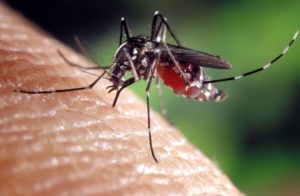21
Dec
Blackberry Leaves Decompose to Thwart Mosquito Breeding
 (Beyond Pesticides, December 21, 2019) A study at the University of Maine (UMaine) finds that adding blackberry leaf litter in stormwater catch basins creates an “ecological trap,” enticing mosquito females to lay eggs in sites unsuitable for larvae survival. Employing this new and incredibly viable “attract-and-kill’ tool for mosquito control shows potential for preventing the breeding of mosquitoes that may carry insect-borne diseases, especially in urban environments. Stormwater catch basins regularly accumulate leaf litter, which serve as habitat for the mosquito species Culex pipiens (Cx. Pipiens) that may carry West Nile virus.
(Beyond Pesticides, December 21, 2019) A study at the University of Maine (UMaine) finds that adding blackberry leaf litter in stormwater catch basins creates an “ecological trap,” enticing mosquito females to lay eggs in sites unsuitable for larvae survival. Employing this new and incredibly viable “attract-and-kill’ tool for mosquito control shows potential for preventing the breeding of mosquitoes that may carry insect-borne diseases, especially in urban environments. Stormwater catch basins regularly accumulate leaf litter, which serve as habitat for the mosquito species Culex pipiens (Cx. Pipiens) that may carry West Nile virus.
Previous University of Maine research discovered decomposing leaf litter from Amur honeysuckle (Lonicera maackii) and common blackberry (Rubus allegheniensis) produces chemical compounds that attracts and stimulates Cx. Pipiens female to oviposit, or lay eggs.
Investigating the attractiveness and lethality of varying catch basin conditions to mosquitoes, researchers hypothesized that blackberry leaf litter could be shown to be lethal to developing mosquito larvae, and, therefore, act as a natural ecological trap for Cx. Pipiens.
Five varying treatments were applied to a total 50 catch basins. Treatments included (1) all debris dredged weekly throughout the duration of the study, (2) no change to debris naturally occurring in catch basins, (3) ecological trap: naturally occurring debris dredged prior to administering 100 grams of fresh blackberry leaves submerged underwater in mesh bags, (4) attractants only: same as previous, except 100 grams of fresh honeysuckle leaves submerged, (5) toxins only: common larvacide Bacillus thuringiensis var. israelensis (Bti) administered, with no additional change to debris.
Catch basins were those on street edges in relatively standard residential neighborhoods. Larvae in catch basins were counted once prior to and four times after treatments had been administered. Floating emergence traps were placed to capture adult mosquitoes. Experiments were repeated across two years to confirm findings.
Results show catch basins with the ecological trap (blackberry leaves) have consistently higher numbers of Cx. pipiens eggs, but very low larvae survival. Honeysuckle, however, showed high larvae survival and high adult emergence. Most strikingly, ecological trap catch basins showed reduced larvae survival even when combined with equal parts honeysuckle.
In addition, with decomposing leaf litter previously shown to attract Cx. pipiens oviposition, the study also confirms that survival of mosquito larvae, being filter-feeding invertebrates, is dependent mainly on the aquatic habitat containing the appropriate bacterial community to suit the larvae’s nutritional needs. However, suitable bacteria, unlike decomposing leaf litter, do not create chemical attractants. This means Cx. pipiens females select oviposition sites based solely on the presence of decomposing leaf litter, regardless of whether the appropriate bacterial community may be lacking. Thus, researchers suggest Cx. pipiens can be tricked to oviposit in sites incompatible for ensuring larvae survival.
“The abundance of mosquitoes in aquatic habitats and the efficacy of conventional insecticides for juvenile mosquito control are strongly influenced by variables such as rainfall, water chemistry, and the species and structure of terrestrial vegetation in the surrounding environment,” says Allison Gardner, PhD, an assistant professor of arthropod vector biology at UMaine and lead author of the study. “This suggests that ecologically based strategies could [be exploited] for environmentally safe and sustainable mosquito abatement,” Dr. Gardner continued.
Dr. Gardner’s study confirms the importance of understanding the suitability of potential habitat for unwanted insect species. Managing conditions conducive for mosquito species’ proliferation prevents human exposure to mosquito-borne pathogens, as mosquitoes do not travel far from where they hatch.
Conversely, broad-spray, conventional management approaches create insecticide resistance among mosquitoes. They also create toxic conditions that harm non-target species like pollinators, including harms to pets and children.
Meet with elected officials to discuss Beyond Pesticides’ public health mosquito management strategy. Tell them to fix the problem conditions that lead to mosquito proliferation in your neighborhood and not to waste more time and money on routine insecticide spraying. Help them understand what attracts mosquitoes to an area, and what sustains them. Talk with city officials about developing novel and intuitive “attract-and-kill” mosquito management strategies that include blackberry leaves. Teach them that corralling Cx. pipiens eggs into simultaneously attractive and inhospitable habitats would be effective for mosquito management and disease prevention, as it adversely affects Cx. pipiens egg production and reduces larvae survival.
Exploiting ecological traps holds potential for new jobs and volunteer opportunities. Encourage the planting of blackberry bushes in your community. Collect fallen leaves and devise ingenious ways to administer the leaves into catch basins (such as being submerged underwater in mesh bags).
When speaking with neighbors, emphasize the ineffectiveness of pesticides at controlling mosquito populations. Discuss the safer choice. Purchase Beyond Pesticides mosquito doorknob hangers and teach neighbors simple mosquito reduction steps, such as: removing unnecessary debris on your property, and cleaning rain gutters in the spring and fall. Offer to help elders and disabled members of your community. Work with friends to create a system for effective mosquito prevention.
All unattributed positions and opinions in this piece are those of Beyond Pesticides.
Sources: Phys.org, and The Royal Society











… and we need way more blackberries, so this will work great!
December 24th, 2018 at 11:24 amGood work! Good to know someone is really watching out for the environment.
December 25th, 2018 at 12:41 pmI just told the City of Toronto about this. They still use Methoprene in catch basins.
May 10th, 2021 at 1:25 pm